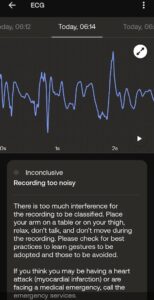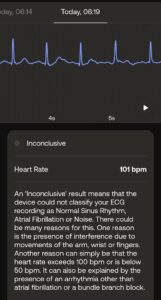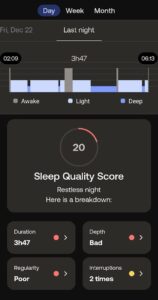Disclaimer:
I know that the Withings ScanWatch is NOT a product sold in India, and the ECG feature is unavailable to all users. It is ‘certified’ to be useful for users in some countries only! My review is not meant to challenge any claims or refute any marketing material published by Withings for any of their ScanWatch models.
Prelude:
Those who know me or discuss tech with me regularly would be well aware of my fixation for:
1. Not wearing ‘blackholes’ or blank black screens
2. Strong aversion to ‘charging’ watches
and
3. Desire for ‘Hybrid Watches’.
Some of you may also have borne the brunt of my gross misadventure with the Titan Connected X (again, the X signifies the hybrid).
After Casio’s recent orphaning of the ProTrek line-up, my infatuation with the Garmin Instinct Crossover Solar almost reached obsession levels.
Months of price-tracking and waiting for the right opportunity bore fruit. It was finally at a price point I felt to be VFM.
Sadly, as luck would have it, the price was perfect, but only in the US of A … and I need acquaintances to help me procure one!
Randomly, out of the blue, an opportunity presented itself in the form of a very, very dear friend, but via a UK channel.
Garmin prices matched the digits/numbers but not the symbol in front of the numbers. Shattered! It’s too much of a stretch to make.
A little desperation made me start looking at other options.
While trying to figure out which brands were partial to this side of the pond, I came across an old flame… the Withings ScanWatch and Steel HR. The old flame had upgraded itself with new sensors and new designs. I was instantly drooling at the ScanWatch Nova and the ScanWatch 2. (The ScanWatch Lite did not excite me at all).
A lot of research started on a war footing. I had a folder full of data from the Nokia Steel HR days (2016-2017) before it was repurchased and renamed to the original Withings brand.
The new watches had a slightly better design, better screen, temperature sensor (amongst hardware changes), and a few software tweaks.
What I would need to include from the GICS: Solar charging, ABC sensor, and rugged nature (not exactly good).
I would get a discreet display and super sleek design + ECG functionality!
I had to try the ECG feature due to my interest in healthcare tech.
Around the same time, my father rejected a Tissot PRX (auto), chimed in with my enthusiasm and agreed to the ScanWatch Nova as a more ‘useful’ product for the price.
While going through the ‘Beta mann me laddoo photos phase’ and ‘Chan se tooth jo koi sapna phase’ together, I realised I was too emotionally invested in the decision. I sought some perspective from individuals whose opinions and acumen I genuinely respect.
This got me some glowing reviews for the Withings and some new curiosity.
But the best of all – it saved me hundreds of dollars!
A sheer stroke of luck, a fellow tech connoisseur, and a swift, warm, and whole-heartedly wholesome deal brought a ScanWatch one on my wrist in less than 48 hours and at 1/3rd the price.
The Use Case
The watch, which can most rightfully be called one, is a B-E-A-utiful. Smooth design, very tastefully done. It works exactly as advertised. Reasonably accurate. It is a head-turner, a conversation starter, and yet genuinely functional.
Within the first 12 hours, I had decided that sooner or later, this needed to find its way on my Dad’s wrist, and I should keep my wrist open to pursue the Garmin whenever possible.
So, after a few days, I urged him to try it on. So far, the ECG feature has yet to work for me. The watch kept throwing up a report ‘Inconclusive’ because my heart rate was above 100. Unknown to me, I would see a lot more of this. Over the next few days, my heart rate spiked to 140+ for a prolonged duration, owing to a massive viral infection with a high rate of fever. But, to re-check the ECG feature, I tried it on my father’s wrist. In reality, this was the first ‘Normal’ ECG I recorded on the app, and I got to explore the feature properly.
I was happy and further resolved that this was best suited for him.
Fast forward a few days later. My viral fever has settled, taking a significant toll on my health, but finally, my heart rate was in the 76 range, and I managed to record my first ever ‘normal’ ECG on the Withings ScanWatch.
The next day, at 6:12 AM, my Dad laboriously walks into my room and feebly asks me to check his ECG on the ScanWatch. He was in pain. I sprung to action.
ECG showed Inconclusive. ‘Recording too noisy’
Second attempt: Inconclusive. ‘Heart rate above 100’
No, the App did NOT detect an ‘abnormality’ as it is trained to detect Atrial fibrillation only.
But, what it did do – was alert me that something was amiss, and I could browse some segments of the ECG on the screen.
I instantly knew something was not right.
This device always reads this person’s ECG as ‘normal’. His resting HR can’t be 100. Brought out the sphygmomanometer. 180/120
Clinical correlation – not just machine readings – things were NOT fine.
No further time is wasted; we have swung into action immediately.
I grabbed my go-bag and left straight for the hospital. (Ambulance didn’t come – at all – wasted 7 minutes).
Extremely callous parking by some society member ensured I wasted another 5 minutes trying unsuccessfully to take my car out.
Luckily, I got a cab. I made various calls in that cab ride – most important to the second pillar of my life, while I held on tightly to the first.
Seven minutes later, the proper ECG at the hospital confirmed the worst – Myocardial infarction. Active. BP 180/110. Pulse 52.
Over the next 90 minutes, some smart-thinking, some genuinely talented good people, and lots and lots of prayers and good wishes got us through an OT in the nick of time.
Thanks to some skilled and experienced hands, the resultant outcome was worth celebrating!
So – while the ScanWatch could not detect the MI, using it repeatedly and regularly could indicate something ‘abnormal’—a deviation from normal. Then, clinical judgement and common sense have to play their respective roles to have favourable outcomes.
The Future
What I would love to have in such personal fitness – or rather, more importantly – health tracking devices:
1. Fall Detection
2. Heart Rate
3. SpO2
4. Blood Pressure
5. Temperature Sensor
6. eSIM – to enable calling and data (why? #7)
7. Send out an SOS message or call upon fall detection or in case of a manual SOS trigger
8. Inbuilt GPS – for better location tracking
9. NFC and some ‘Pay’ features. Very useful in some scenarios.
Such a device would be helpful for both senior citizens and children (tracking).
The eSIM issue:
Simple use case. Instead of a full-fledged smartphone, I wanted to give someone their number in a ‘feature phone’ to ensure zero distractions, notifications, or WhatsApp but allow the primary purpose of a phone – communication.
I had recently acquired the ‘scarce’ Jio Phone Prima for such days. Works well. (different topic).
But that’s where the plan hit a significant roadblock!
How do you transfer an eSIM to a physical SIM for a dumb phone in emergencies?
It is too much of a task to visit a store to go and convert the SIM.
Jio, Airtel, and late-to-the-party Vi have some decent options to get an eSIM from a physical SIM online – without visiting the store.
But the reverse? That is not possible.
This may seem like a rare, one-off incident. Right?
Well… no. Not exactly. Just a couple of months ago, I managed to ‘drown’ a phone (again, different story, some other time) and was stuck without a ‘phone’ because I didn’t have a SIM that I could put in another feature phone or smartphone (which was not capable of eSIMs). There was no MSP store for about 60 km.
I will be converting all my eSIMs to physical SIMS, except, of course, the iPhone – because that’s the only way to have ‘Dual SIM’ on my particular Indian-origin iPhones… and wait for the Tricorder to become a wrist-based reality.





